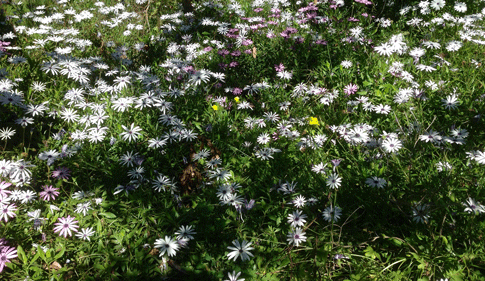Daisy, Daisy give me your answer do
- rosemarydearman1
- Oct 25, 2016
- 4 min read
"It is not spring until you can plant your foot upon twelve daisies" Proverb

Spring has sprung and there are daisies everywhere. The picture above was taken last week on my Eltham walk. It seems to me that the suburban gardens I pass - both the well tended and the wild, are dominated by daisies at the moment. And how beautiful they are. The title of this article is meant to imply that I have to somehow find a connection to food whilst talking about daisies. Actually not too hard.
But first of all a little gallery of shots I took this morning on today's walk. Just to show you the variety and the beauty of this most simple and basic little flower. Even the weedy shasta daisies (second photo down on the left) growing in the nature strip - indeed taking over the nature strip - are lovely.
Daisies are like sunshine to the ground.” Drew Barrymore
(Drew Barrymore of all people! - but it's really quite a nice little quote)
In some ways the most spectacular display is that of the mass of golden daisies - and these are from a garden which is obviously not cared for. The grass is high and the weeds are rampant, but these beautiful daisies triumph over it all. Apparently daisies are the most widespread type of plant in the world - there are daisies on every continent except Antartica.
But before moving on to food I wanted to also say that they are a favourite subject for artists - starting with the most famous of all - Van Gogh's sunflowers. Sunflowers are just big daisies after all. He painted many different versions. This is just one of them. They are all worth millions now.

But here are some other examples - two more by Van Gogh who is the king of flower painters of course, But also - in order - Berthe Morisot, Henri Fantin Latour, Margaret Preston, Andy Warhol, Henri Matisse, those two more by Van Gogh, Georgia O'Keefe.
So daisies. The name is from the old English dægeseage meaning day's eye. Chaucer wrote some rather nice lines about it in the Prologue to his Canterbury Tales. I won't translate it for you - if you stare at the words long enough I think you can see what it means. The most difficult word is perhaps 'emperice' which I take to mean empress.
"That wel by reson men it calle may
The 'dayesye' or elles the 'ye of day'
The emperice and flour of floures alle."
They are a cheerful kind of flower I think, simple, pretty, abundant. You rarely get one daisy on its own. My own garden even has a few varieties. The few shasta daisies in my garden are weeds, but the rest of them are deliberately planted.
It's a lovely girl's name - well it used to be very popular - hence the title of the article - words from an old music-hall song. I think it has yet to come back like Lily and Rose, but I think it will. Daisy chains - I used to love making them - I vaguely remember sitting on the grass at high school even, making daisy chains. And here is a beautiful photo of my younger son at a very young age, with a daisy chain crown - shasta daisies I think.

It was a long time ago. And then there's the 'he loves me, he loves me not' routine that you do as you pull off all the petals. We have a series of four paintings on our wall, painted by a friend, featuring daisies. One of them shows the daisies in various stages of having had petals pulled off. I tried to take a photo but it was just too difficult.
They have medicinal uses - and here we come to food.
I am ignoring the fact that I read that we can eat daisies themselves and their leaves too, sometimes. Well we mostly wouldn't want to would we? But there are two daisy plants that we do use as food regularly. The first is camomile or chamomile - a favourite herb tea, the taste of which I find personally disgusting, but others, including my husband, don't. If you read the various websites around you could believe that camomile can cure just about anything - but I think it's mostly used as an aid to sleep. It's very common. You can buy big boxes of it in the supermarket.
Then there is the beautiful sunflower. A huge cash crop in Southern France, and lots of other places too. In France they call it the 'tourne soleil' because it turns to face the sun throughout the day. The vast fields of sunflowers are a sight to behold. Their seeds are what are used - as seeds in various cereal and bread related products, and as oil. So there's the answer - camomile tea and sunflower seed and oil.
"Always have something beautiful in sight, even if it's just a daisy in a jelly glass." H. Jackson Brown, Jr.
For they are indeed stunningly beautiful and they lift my spirits.
















































Comments